Configuring 3D Processor Presets
3D Processor Presets
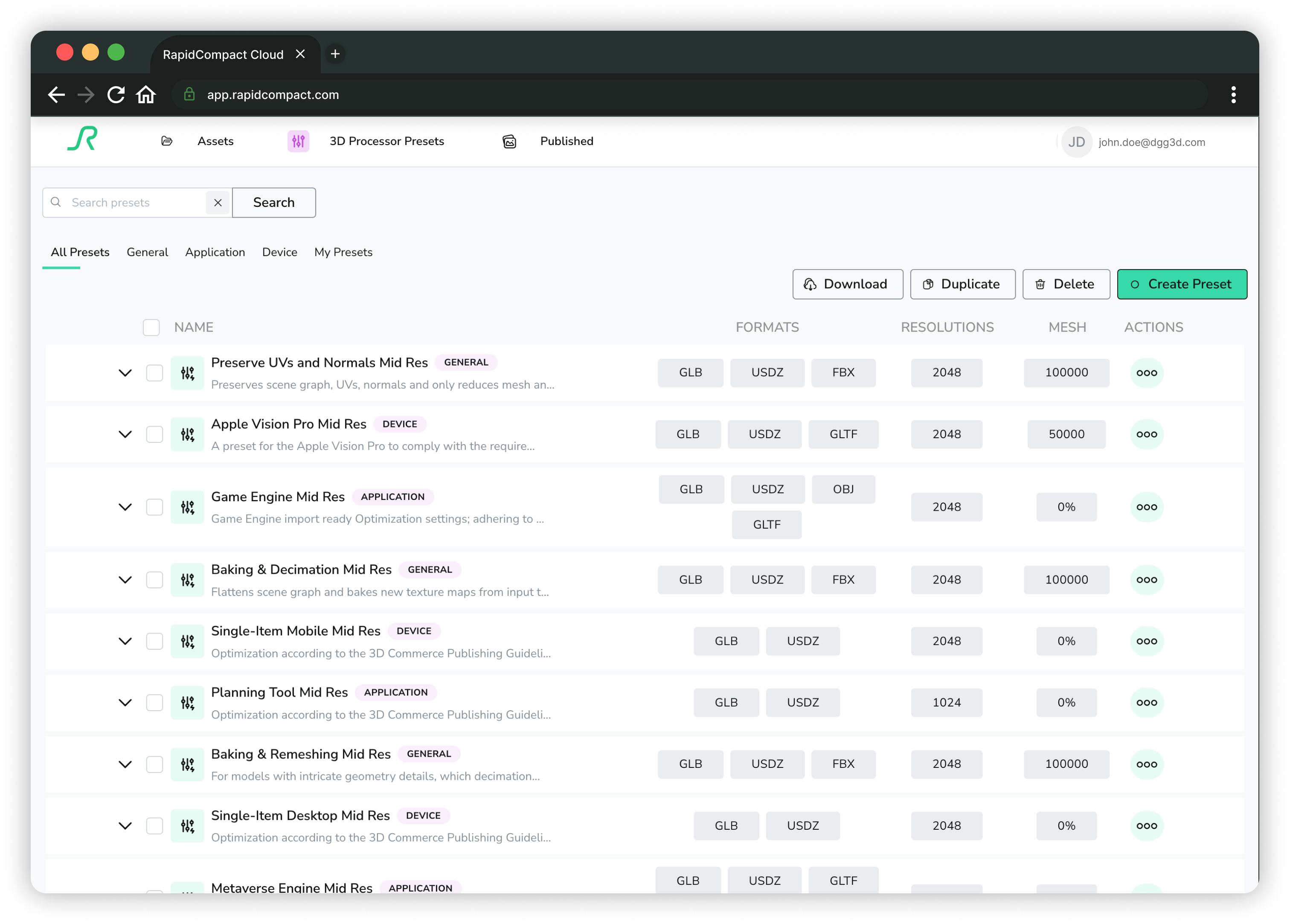
Presets are saved 3D processor settings that are found on in 3D Processor Presets page as well as in Select a preset modal when you run 3D processor for a select list of assets.
These presets are organized under three tabs:
- All presets: This self explanatory list contains all the presets and makes searching all presets by a keyword easier.
- General: We have created these presets to demonstrate features (Remeshing, Decimation, Baking, Preserving UVs, etc.) of our 3D processor
- Application: These are created for limitations and requirements of certain platforms.
- Device: These are created for models to work with high performance in specific devices.
- My presets: These are your custom presets
3D Processor Preset Settings
When the factory presets are not cutting it for you, you can dig into the settings of RapidPipeline 3D Processor yourself and create a custom preset.
The custom preset editor offers you the possibility to dive deep into the core optimization features, view detailed factory preset settings and create your own custom presets that fit to your specific needs and requirements.
Limits
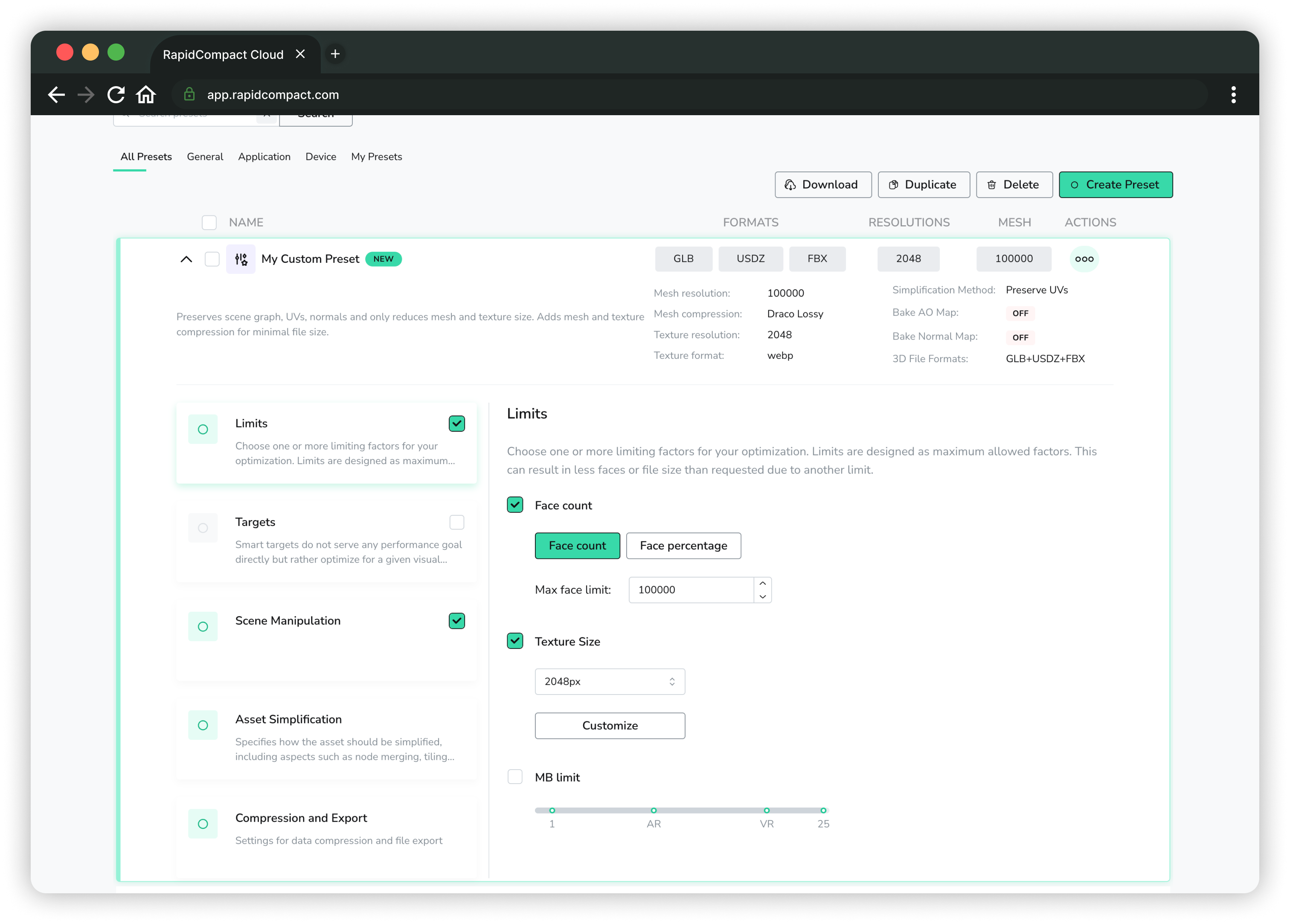
In the Limits section, you can set a maximum Face Count or a relative Face Percentage value as a hard requirement for your model.
If you want to tell the software that you want to keep your mesh as-is, choose a face percentage value of 100%
The software also lets you choose a texture size. If you want to configure this for each PBR material texture channel, click Customize.
Another type of limitation you could set for the software is the final MB limit. Set this if you have very strict file size limitations.
Targets
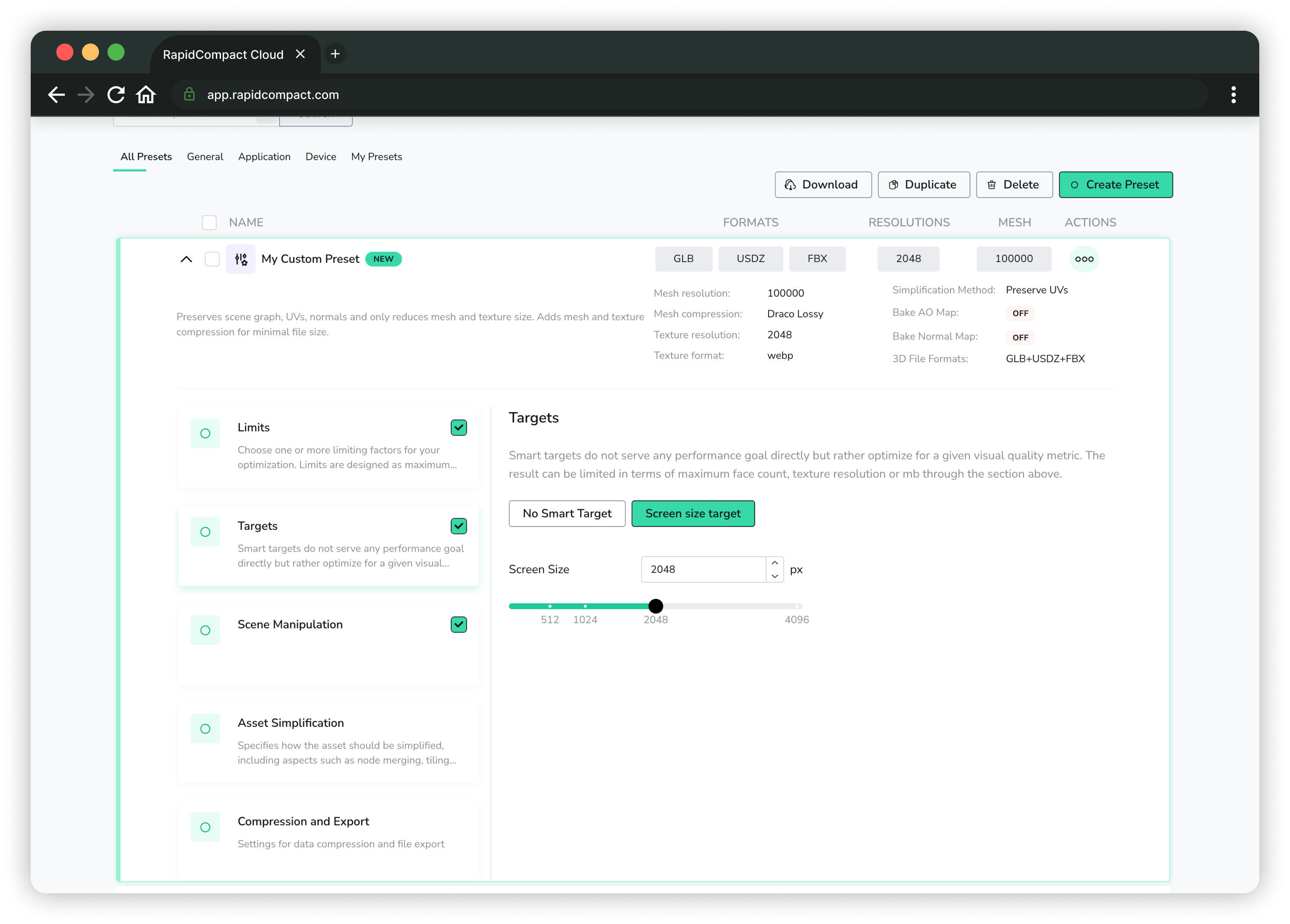
In addition you can also use the new "Smart Targets" and define the output screen space resolution of the model. As this process tries to give the most accurate deviation to the input model in relation to the target amount of pixels (visual quality driven metric), it is recommended to limit the output file size using the MB target and/or limit the output polygon count and texture size using the "Face Count" and "Texture Size" options respectively.
Scene Manipulation
Scene manipulation settings allow you to control whether you want to keep or remove small or invisible geometry in your scene as well as help you control model orientation such as rotating Z up.
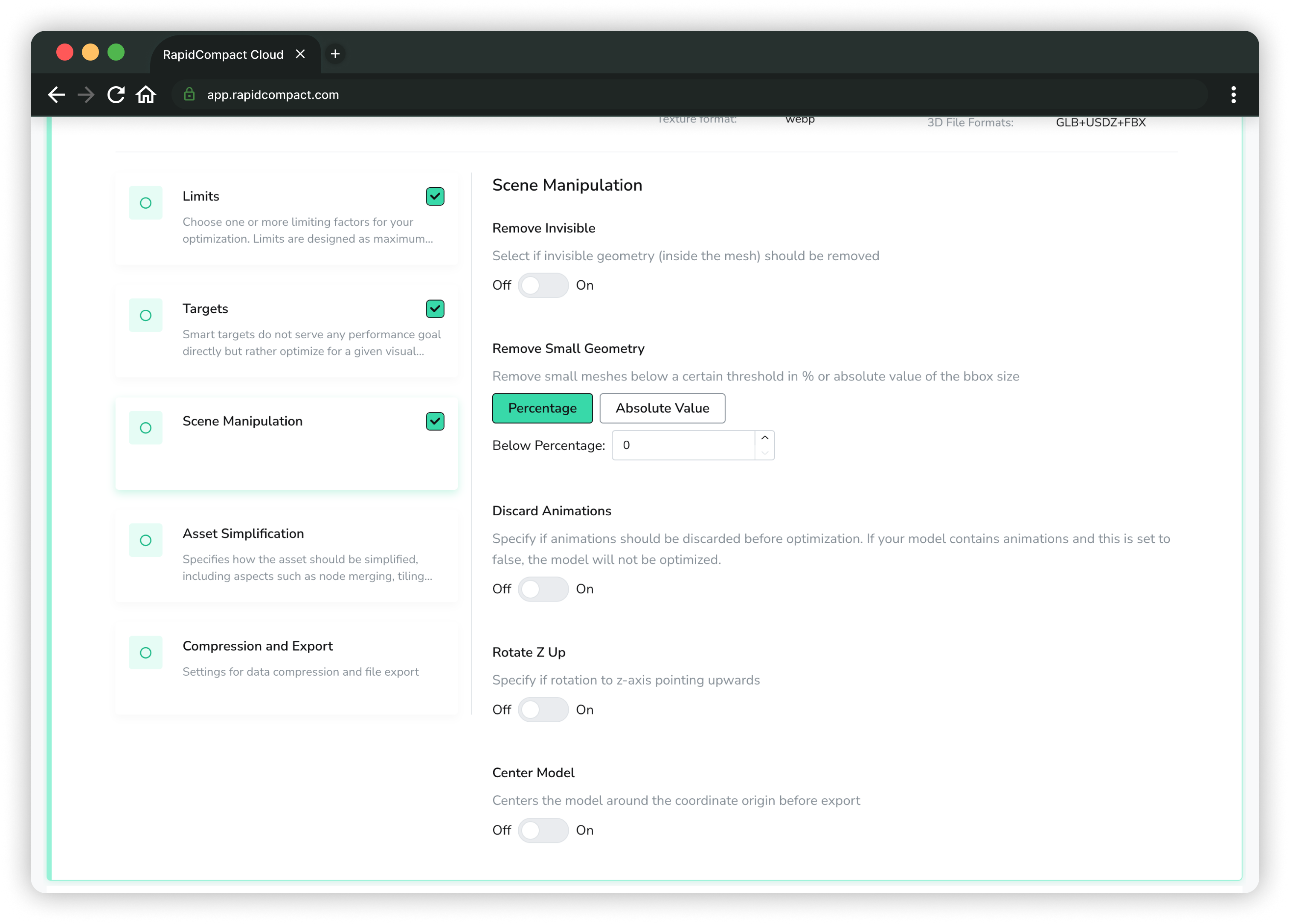
| Setting | Description |
|---|---|
| Remove Invisible Geometry | Select if invisible geometry (inside the mesh) should be removed |
| Remove Small Geometry | Removes small meshes below a certain threshold in % or absolute value of the bounding box size |
| Discard Animations | Specify if animations should be discarded before optimization. If your model contains animations and this is set to false, the model will not be optimized. |
| Rotate Z Up | Specify if rotation to z-axis pointing upwards |
| Center Model | Centers the model around the coordinate origin before export |
Asset Simplification
This section consists of all the required settings for RapidPipeline.
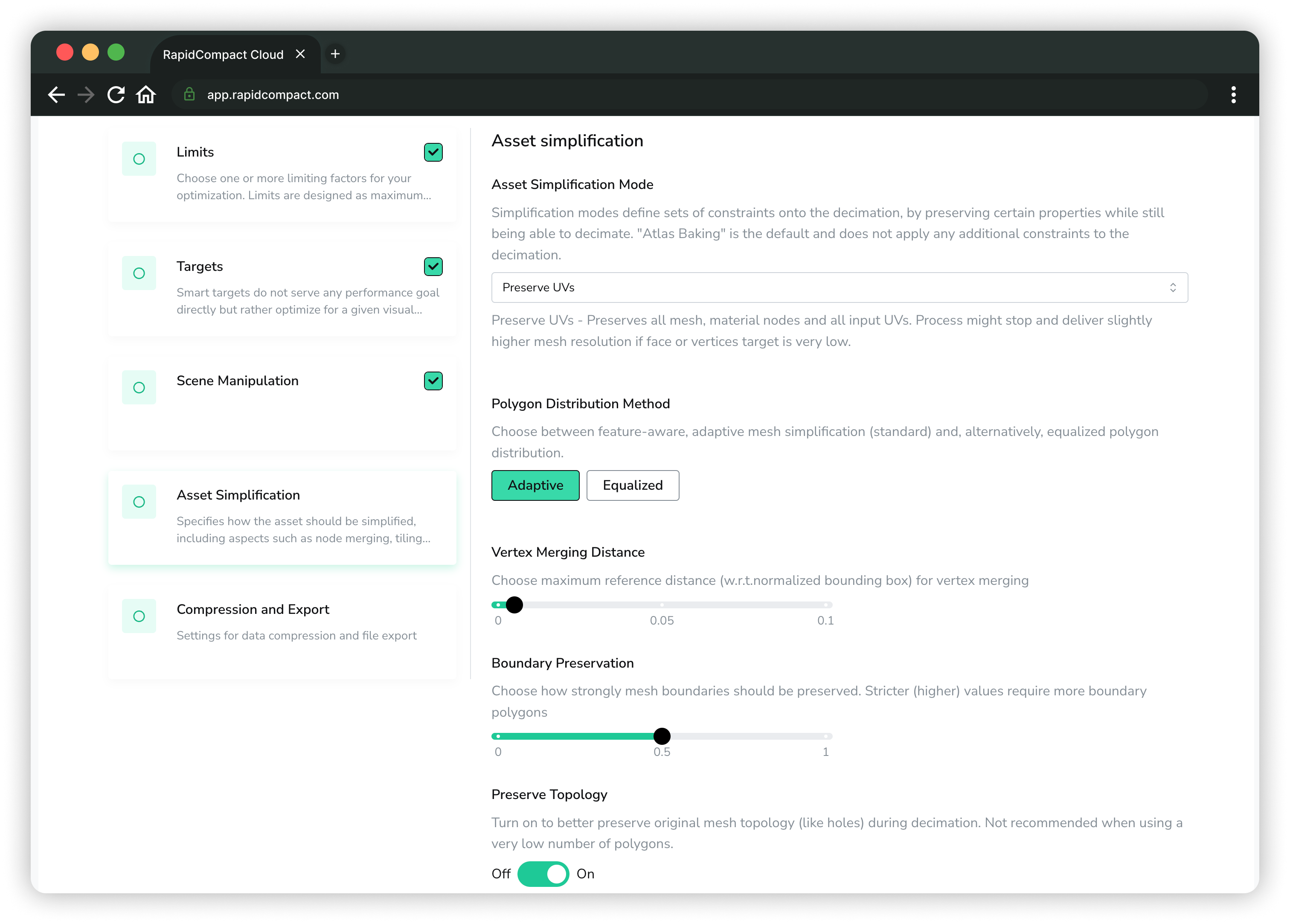
Asset Simplification Mode
The first choice here is between 5 differend Simplifiction Modes (These modes are based on API equivalents) :
| Mode | API equivalent | Description |
|---|---|---|
| Atlas Baking | "rebake" | Aggregates all UVs and creates a unified layout, bakes all information to new UVs. |
| Remeshing (keep alpha) | "remeshing-keep-alpha" | Same functionality as Atlas Baking method with the addition of utilizing a remeshing process before decimation, which can be beneficial to reach low mesh resolution results and deal with complex input data such as Digital Fashion. |
| Remeshing (bake alpha) | "remeshing-bake-alpha" | Same functionality as Remeshing (Keep Alpha) method, but instead of preserving meshes, materials associated with alpha textures, everything gets merged and the opaque parts of the alpha textures gets baked on top of the remeshed surface. |
| Preserve Tiling | "preserveTiling" | Preserves input's tiled UVs and textures. Non-tiling UVs will be aggregated and baked as in "Atlas Baking" mode. If ao is enabled will be baked into a new 2nd UV set. |
| Preserve Mesh & Material Nodes | "rebakepreserveNodes" | Preserves all mesh and material nodes. Aggregates all UVs per material and bakes information to these new UVs. Can lead to a high number of output texture maps and draw calls! |
| Preserve UVs | "preserveUVsAndNodes" | Preserves all mesh, material nodes and all input UVs. Process might stop and deliver slightly higher mesh resolution if face or vertices target is very low. |
| Drop Textures to Material Colors | "dropTextures" | Averages the color of input texture maps and converts to material colors. Avoids baking and textures. Results in very low file size, but might produce more draw calls than "Atlas Baking". |
Depending on the chosen mode the optimization outcome can be quite different in terms of visual fidelity but also in terms of performance; here is a chart illustrating the different modes and their (dis)advantages:
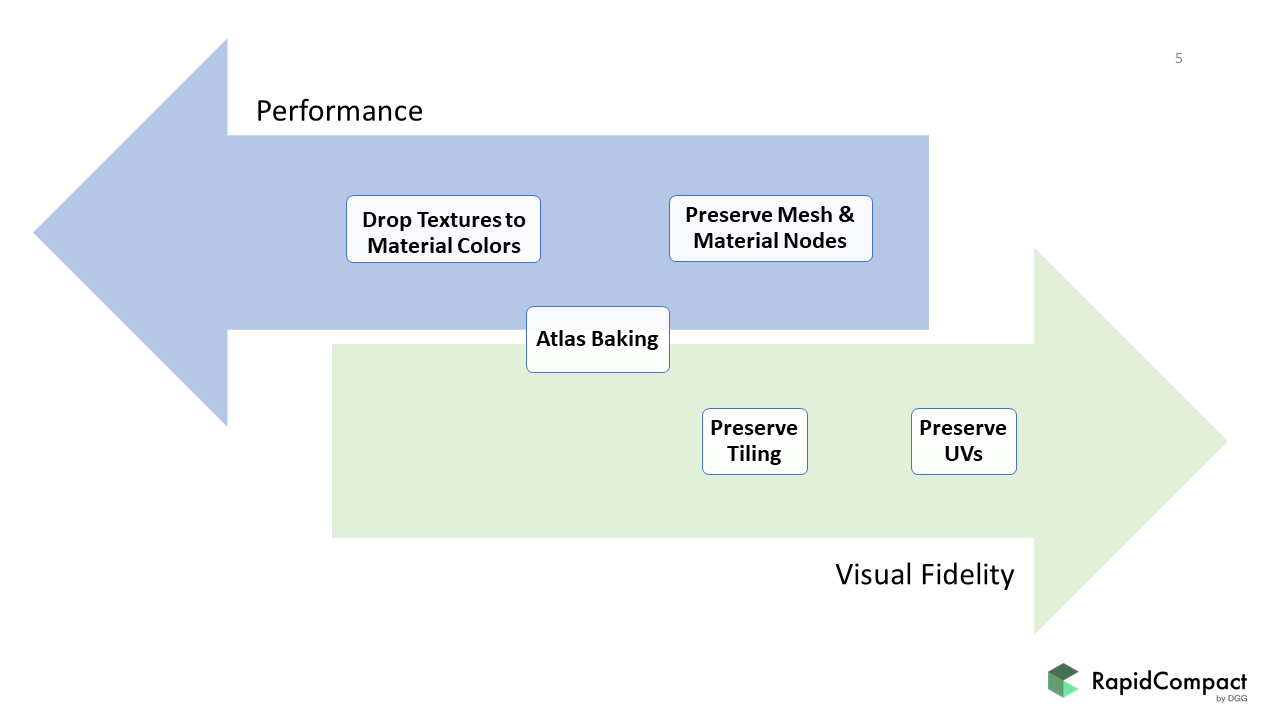
As you can see the default Atlas Baking delivers average visual quality output and quite good performance optimization. If your input content comes with a limited amount of meshes and materials (draw calls) and already has optimized UV layouts and textures, we would recommend the Preserve UVs mode as it preserves the visual fidelity and otherwise only improves performance by reducing polycount and/or texture resolution.
Further Topology Settings
- Topology Settings (Mesh Decimation Settings)
- UV & Atlas Settings
By default the settings are optimized for a average to good quality in terms of mesh, UV and texture optimization and focussed on fast computation performance. In the following an overview over the settings and possible consequences:
| Setting | Min/Max value | Consequences |
|---|---|---|
| Polygon Distribution Method | 0 / 1 (Adaptive vs Equalized) | Adaptive gives the best polygon distribution (less on flat angles, higher on details & more organic shapes surfaces) |
| Vertex Merging Distance | 0 - 0.1 (Range) | Vertex Collapses during Decimation. If you not know what this is, we recommend default value. |
| Boundary Preservation | 0-1 (Range) | Preservation of Mesh Boundaries. If you not know what this is, we recommend the default value. |
Materials & Textures
| Setting | Min/Max value | Consequences |
|---|---|---|
| Baking Quality | 1-3 (Medium vs Low vs High) | The higher the more baking passes, thus the better the quality but the longer the computation. |
| Bake Normal Map | On / Off | Bakes normal map from input geometry + input normal maps if existing. Improves lowpoly mesh surface appearance. |
| Bake AO Map | On / Off | Bakes ambient occlusion maps. This improves visual fidelity, but increases computation time. If used with "Preserve Tiling" mode, 2nd UV set will be utilized |
| UV Creation Method | 0 - 1 (Hard Surface vs Organic) | Different Auto-UV layout methods. The Organic variant might take a lot longer to compute and results in less charts. Not recommended for any hard surface assets such as furniture. |
Output & Export Settings
The last section covers mesh & texture output formats as well as mesh and texture compression methods. The mesh compression method (draco, dracoLossy) is only available for glTF/GLB and the texture compression can be chosen in the texture formats drop down.
For supported 3D Output formats & compression methods please refer to our Asset Guidelines.
Finally in this section you can also modify your output asset name:
- Include Model ID: Includes the internal (RapidPipeline) ID into the model name, this can help you identify which model was the latest one in case you edit the same preset and process the same file multiple times.
- Include Preset Name: This can help you distinguish which settings were used for which model.
- Include Custom Suffix: If the standard options aren't good enough, you can pass your custom string to be added atthe end of your model name.